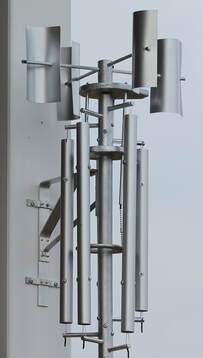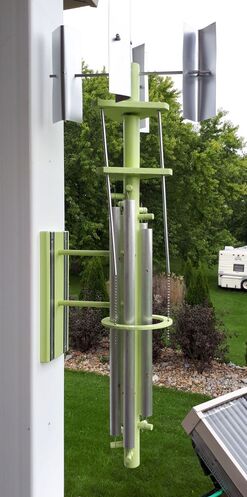Version 3 (above left) and version 4 (above right) of my "wind-proof" chimes.
The winds in Prince Edward County can be cruel. They abuse normal wind chimes. In response I offer my not-as-good-sounding, much-more complicated "wind-proof" design. No problem is safe from an over-complicated solution. Note that "wind-proof" is in quotation marks. The wind destroyed version 3.
In both designs the four sails rotate a top cylinder. An offset collar at the base of the cylinder moves the top plate in a rotary motion. The three thin tubes that support the top plate pivot on the lower, fixed plate and transfer the motion to a circular striker via a short chain. Version 3 had the striker inside the chimes but that made it difficult to assemble and restricted the striker's motion. Version 4 is easy to assemble and has more room for the striker to swing giving a better sound.
Another difference is that version 3 had a lot of machined metal (lathe work). Version 4 was made with hand tools except for some work on a drill press.
The big difference between these designs and normal wind-chime designs is that in normal designs the chimes move away from the striker when hit. This allows them to ring freely. In these designs the chimes are fixed at both ends (to stop them from going horizontal in strong winds). It the striker is too heavy it smothers the sound before bouncing off. Too light a striker gives a tinny sound. 6mm thick plywood is a good compromise.
The winds in Prince Edward County can be cruel. They abuse normal wind chimes. In response I offer my not-as-good-sounding, much-more complicated "wind-proof" design. No problem is safe from an over-complicated solution. Note that "wind-proof" is in quotation marks. The wind destroyed version 3.
In both designs the four sails rotate a top cylinder. An offset collar at the base of the cylinder moves the top plate in a rotary motion. The three thin tubes that support the top plate pivot on the lower, fixed plate and transfer the motion to a circular striker via a short chain. Version 3 had the striker inside the chimes but that made it difficult to assemble and restricted the striker's motion. Version 4 is easy to assemble and has more room for the striker to swing giving a better sound.
Another difference is that version 3 had a lot of machined metal (lathe work). Version 4 was made with hand tools except for some work on a drill press.
The big difference between these designs and normal wind-chime designs is that in normal designs the chimes move away from the striker when hit. This allows them to ring freely. In these designs the chimes are fixed at both ends (to stop them from going horizontal in strong winds). It the striker is too heavy it smothers the sound before bouncing off. Too light a striker gives a tinny sound. 6mm thick plywood is a good compromise.


